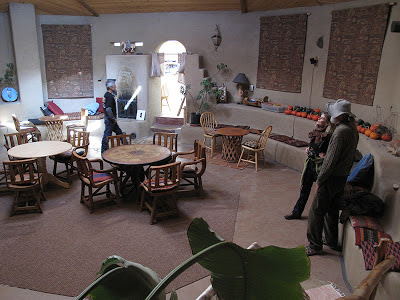 |
| Listening to Seed Stories in the Mobile Seed Story Broadcasting Station |
Seed Broadcast visited the University of Central Arkansas, Seed Lab, on August 7, and met up with folks from
Conserving Arkansas's Agricultural Heritage (CAAH!), the
Arkansas Local Network, the
Central Arkansas New Agrarian Society (CANAS), the Faulkner Public Library, local permaculturalists, farmers, gardeners, and a really old jar of white beans, brought in by Nancy Duke.
Dr. Brian Campbell discussed how the CAAH! - Seed Lab and Seed Library operates and also described the challenges of community seed saving and sharing: asking others to contribute to this local seed action. CAAH!, helps regional communities start their own yearly seed swaps and promotes growing, saving, and sharing of local heirloom varieties. They have also been busy creating a regional seed library, as well as, producing feature length videos and organizing educational workshops. Check out their latest video
Seed Swap. And keep an eye out for more, coming soon.
As a group, we held a round table discussion, where everyone shared thoughts from their gardens and concerns over the drought. The entire region, much like the entire country is suffering under extremely dry conditions. This looked like the worst yet, with leaves from trees shrivelling, turning brown, and dropping. People also shared another major environmental concern: fracking. With seismic quakes rumbling in the area, local concern and outrage has stopped the industry for now, until further study can be conducted. On top of this, is the inevitable fear that water sources will be polluted.
 |
| Nancy Drakes, very old jar of white beans.... |
Even when facing issues like these, which seem bigger than any one person can deal with, the conversation returned to what is being done. Planting, growing food, digging in the dirt, saving seeds, finding seeds long thought lost, and sharing a wealth of care and commitment. It was said, that the only way we can grow stronger and more resilient is by doing. Just like plants adapting to climate change, pursuits at growing our own food, are only possible by continuing to plant, save, and share seeds of resistance.
 |
| Angela Gardner, a local gardener, loves popcorn, and loves to grow, save, and share these stories. |
Dr. Campbell generously shared several of his published articles on Ozark biodiversity, traditions, and open pollinated seed swaps, check these out below:
"Closest to Everlastin'": Ozark Agricultural Biodiversity and Subsistence Traditions
Open-Pollinated Seed Exchange: Renewed Ozark Tradition as Agricultural Biodiversity Conservation
Thank you Brian, Angela, Michael, Gerald, Nancy, W.C., Bryan, and McKenzie!
The Seed Stories from Conway are coming. So check back in the next couple weeks for audio Seed Stories from CAAH!
Also, coming soon is the next Seed Story Broadcast, from the farm of Herb Culver, an Ozark seed saver, in Deer, Arkansas.



















































.JPG)


.JPG)